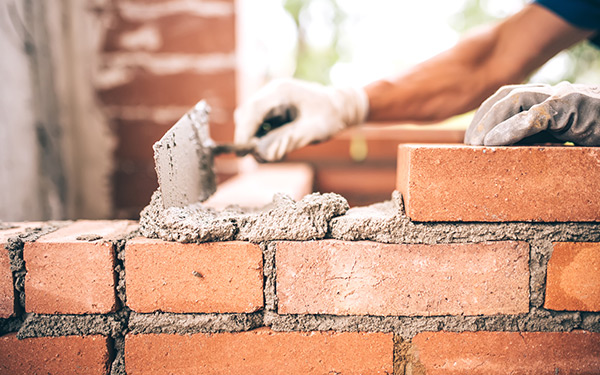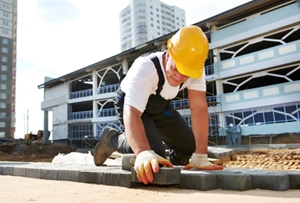Trusted Tuckpointing Services for Improving Block and Rock Surfaces
Wiki Article
Unlocking the Tricks of Lasting Masonry Building Practices for Eco-Friendly Structures
Among the myriad approaches to green structure, lasting masonry construction stands out as a tried and true and sturdy technique that holds a riches of untapped capacity. From the option of materials to innovative construction techniques, the secrets to attaining sustainability within masonry building and construction are diverse and interesting.Advantages of Sustainable Stonework Construction
Embracing sustainable masonry construction practices not only lowers ecological effect but also uses long-term economic benefits to builders and areas. By making use of materials like recycled bricks, obstructs, and rocks, builders can dramatically reduce the carbon footprint of their tasks while promoting resource efficiency. In addition, sustainable masonry building and construction methods, such as appropriate insulation and thermal mass homes, can boost power efficiency within structures, causing decreased functional expenses in time.In addition, the resilience and resilience of stonework structures add to long-lasting financial benefits. Buildings built utilizing lasting masonry practices often call for much less upkeep and repair, converting to set you back savings for home builders and homeowner. The durability of masonry materials likewise ensures that frameworks remain steady and safe and secure, reducing the need for regular improvements or substitutes.
Eco-Friendly Masonry Materials
Making use of environmentally friendly stonework materials is a pivotal action in the direction of boosting the sustainability of construction methods and minimizing environmental influence while optimizing long-term economic benefits. Lasting stonework materials are sourced, created, and used in a way that reduces overall ecological impact. Products such as recycled bricks, recovered stone, and sustainable concrete blocks are becoming progressively popular selections for eco-conscious contractors. Recycled bricks, as an example, not only divert waste from garbage dumps but likewise need less energy to produce compared to brand-new bricks. Redeemed rock provides an one-of-a-kind visual allure while minimizing the need for new quarrying. Lasting concrete obstructs include recycled accumulations and might include enhanced insulation properties, adding to power efficiency in structures.Additionally, all-natural products like adobe, rammed planet, and straw bundles offer excellent thermal mass residential properties, lowering the demand for home heating and cooling down power. These products are usually in your area offered, advertising local economies and reducing transportation-related carbon emissions. By selecting eco-friendly masonry materials, construction projects can dramatically decrease their ecological footprint and contribute to the development of much healthier, much more sustainable constructed environments.
Energy-Efficient Stonework Strategies
Power efficiency plays a critical duty in improving the sustainability of stonework building methods. By executing energy-efficient stonework strategies, builders can considerably reduce the total energy consumption of a structure, bring about reduced functional costs and a smaller environmental impact. One vital energy-efficient masonry method is using thermal mass, which involves integrating dense materials like concrete or block into the building's structure to absorb and store warmth. This helps control interior temperature levels, minimizing the need for mechanical home heating and cooling systems.
Advancements in Sustainable Stonework
Current developments in lasting masonry methods have actually produced ingenious techniques that are improving the building and construction industry. One such technology is the development of self-healing concrete, which uses microorganisms installed within the concrete to heal fractures autonomously. This innovation not only reduces maintenance prices but likewise improves the toughness of stonework structures, adding to their sustainability.
Another significant advancement is making use of recycled aggregates in stonework building and construction - masonry contractor. By incorporating materials such as smashed ceramic waste or recycled glass into concrete blends, building contractors can minimize the environmental impact of building and construction projects while maintaining structural honesty. This technique not only draws away waste from garbage dumps however also conserves natural deposits, making it a vital development in sustainable stonework building and construction
Moreover, the integration of electronic layout devices, such as Building Info Modeling (BIM), is transforming the way stonework frameworks are intended and created. BIM enables more accurate computations, minimized product waste, and improved energy efficiency, ultimately causing more lasting structure methods. These advancements jointly indicate an encouraging future for lasting masonry building and construction in the age of environmentally friendly buildings.
Future Trends in Stonework Sustainability
With the ingenious strides made in sustainable masonry methods, the future fads in masonry sustainability are positioned to more revolutionize the construction market. One of the crucial trends forming the future of stonework sustainability is the boosted integration of modern technology. Advancements such as Structure Information Modeling (BIM) and virtual reality simulations are being made use of to optimize stonework building processes, leading to reduced material waste and enhanced energy performance in buildings.Moreover, the advancement of novel lasting products is readied to play a considerable duty in improving the eco-friendliness of stonework building. masonry contractor. Innovations like self-healing concrete, recycled accumulations, and bio-based binders are step repair getting grip for their capability to decrease environmental effect while keeping architectural stability

Conclusion
To conclude, lasting masonry construction methods offer various benefits for environmentally friendly buildings. By making use of green products and energy-efficient strategies, masonry can contribute to a much more sustainable developed environment. Advancements in lasting stonework are continuously being developed to further improve the environmental efficiency of structures. Looking towards the future, the pattern of stonework sustainability is anticipated to expand, resulting in more eco pleasant and energy-efficient building techniques in the years to come.Report this wiki page